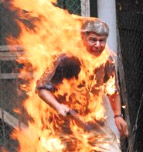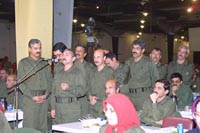The Use of the Philosophy of Martyrdom within Religious Cults for Acts of Terrorism
Martyrdom as an asset for a cult:
Martyrdom for the majority of people from different faiths and nationalities might be an honour, an example of people standing by their values and principals; and perhaps for some the promise of heaven. Some even might believe that their martyred friend or relative, can take seventy of their family and friends to heaven with themselves. But for a cult like Assassins in 11th century or Al-Qaeda or Mojahedin of Iran, martyrs are the greatest assets of all. They gain legitimacy for their goals and the rightness of their path by the number of their martyrs and how brave they were or how horribly they were killed.
Although one might say that the modern history of suicide attacks started with the Japanese Kamikazes. But I think the new phenomenon called suicide bombers started with the Mojahedin’s suicide attacks against Iranian authorities during 1980’s. Let me read part of the will of one of them mentioned in the publication of MKO 19th of June 1982, Gohar AdabAvaz. She killed the Friday Prayer Imam of Shiraz after praying with a few others who were present there. She writes in her will, “I don’t think my life belongs to me, it belongs to God and the people and the Mojahedin organization. If a new path can be opened with my life, then I will be very happy that I be small token in this path. I have chosen this path knowingly, and am waiting that moment of martyrdom, impatiently.”
Let me conclude that the use of the rich philosophy of martyrdom within a cult has given new meaning to martyrdom; it has changed it into new tools for materialization of the goals of the cult.
For example in 2003 when the co-leader of the Mojahedin; Maryam Rajavi was arrested for few days in France, eleven members of the organization set themselves on fire in front of the French embassies in several countries and two of them, one in London, were killed as a result.
Tom Spender, in new shoppers, writes about one of those who set himself on fire in London but survived. He writes:” Hamid, 21, of Lanacre Avenue, Grahame Park, was one of several Iranians across Europe to register the most extreme of protests at the arrest in France of about 160 members of the People’s Mojahedin of Iran (PMOI) – including the group’s leader Maryam Rajavi…. What followed stunned the Western world. Images of men and women silhouetted in flames on the streets of London and Paris dominated the television news. One Iranian in London, Neda Hassani, a 26-year-old Canadian computer science student, later died of her burns. Another woman in Paris also died.” When Hamid is asked why did he set himself on fire? He replies:” "I wanted to shock the world. Injustices are committed all over the world but most of them are not reported well.” And when he asked if he regret? He replies:” It was definitely worth it. I have not for one second thought that I shouldn’t have done it.”
If they can set themselves on fire over the arrest of their leader, what can stop them from using martyrdom as a means for any end?

A scene from ceremony of signing an oath with Mojahedin’s leader in Iraq.
Self burning of a Mojahedin’s member in Paris after arrest of Maryam Rajavi. 2003

